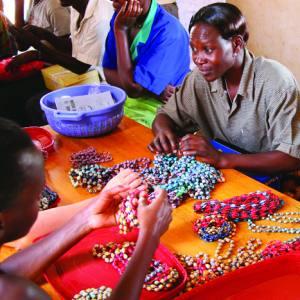
Nearly 700 women have taken part in the BeadforLife program launched in Uganda by three Americans in 2004
This is the VOA Special English Development Report.
Diamonds may be a girl's best friend, as the old saying goes. But some women are finding a lot to like about colorful beads from Uganda made of recycled paper. The beads are sold by a nonprofit organization in the United States called BeadforLife.
BeadforLife began as a chance meeting between three American women on a trip to Uganda and a local jewelry maker. Millie Grace Akena was rolling paper beads near her home. She worked at a rock quarry. She made paper beads as a hobby. But there was no real market for them in her country.
Torkin Wakefield says she, her daughter Devin Hibbard and Ginny Jordan brought some of the beads back to the United States.
TORKIN WAKEFIELD: "Immediately people started admiring the beads. 'Oh, I like this. Where did you get this? It's so pretty.'"
The three Americans launched BeadforLife in 2004. Nearly 700 women have taken part.
The group says its beaders earn an average of more than 2,000 dollars a year in the program. This is five times what they earned before. Torkin Wakefield says the women spend up to 18 months in the program.
TORKIN WAKEFIELD: "During that time she can make regular income and she has a savings account and she begins to study and plan for launching a business, which is her business and which will sustain her once she graduates from BeadforLife. And the program includes a microfinance grant, money that she has actually made by selling us beads that she gets at one time, so that she can make a big enough step into a business that is going to be sustainable."
The beads are sold across Uganda and at the BeadforLife headquarters in Boulder, Colorado. They are also sold online and at jewelry shows called bead parties.
TORKIN WAKEFIELD: "Because they have meaning, because these are gifts that help people, folks in America and beyond, when they buy our beads they feel a sense of generosity. They feel a direct connection, like they can really participate in eradicating poverty."
Acrylic plastic is used to harden the paper. The jewelry costs between five and 30 dollars. BeadforLife reported sales in its last budget year of more than three and a half million dollars. It says for every ten dollar necklace sold, the beader gets two dollars and 43 cents in money or materials.
It says more than 90 percent of earnings are reinvested in community development projects in Uganda. Torkin Wakefield estimates that BeadforLife has helped more than 8,000 people this way.
So what about Millie Grace Akena, the jewelry maker? Mrs. Wakefield says she has gone on to organize a small group of women who work with her, and they sell their beads to a religious group.
And that's the VOA Special English Development Report, written by June Simms. I'm Steve Ember.
quarry: a place where large amounts of stone, etc. are dug out of the ground 采石场
acrylic: made of a substance or fabric produced by chemical processes from a type of acid 丙烯酸的
A compromise on trials for crimes of aggression
Shortage of nurses is worldwide, but worst in poorer nations
Small drug pouch may offer new tool to protect newborns from HIV
Taking action against child labor
(来源:VOA 编辑:陈丹妮)
